STATISTICAL COMMUNIQUÉ OF THE PEOPLE'S REPUBLIC OF CHINA ON THE 2023 NATIONAL ECONOMIC AND SOCIAL DEVELOPMENT
National Bureau of Statistics of China
February 29, 2024
The year 2023 is the first year to fully implement the guiding principles of the 20th National Congress of the Communist Party of China (CPC) and a year for economic recovery and development following three years of COVID-19 prevention and control. Faced with complex and grave international environment as well as arduous tasks to advance reform, promote development and maintain stability at home, under the strong leadership of the CPC Central Committee with Comrade Xi Jinping at its core, all regions and departments took Xi Jinping Thought on Socialism with Chinese Characteristics for a New Era as the guideline, fully implemented the guiding principles of the 20th CPC National Congress and the Second Plenary Session of the 20th CPC Central Committee, followed the decisions and arrangements made by the CPC Central Committee and the State Council, adhered to the general working guideline of making progress while maintaining stability, fully and faithfully applied the new development philosophy on all fronts, accelerated efforts to foster a new pattern of development, strove to promote high-quality development, comprehensively deepened reform and opening up, strengthened macro control, and redoubled efforts to expand domestic demand, optimize structure, boost confidence and prevent and defuse risks. As a result, the national economy witnessed the momentum of recovery. The high-quality development was pursued with solid steps, important advancement was achieved in the building of a modern industrial system, new breakthroughs were made in scientific and technological innovation, reform and opening-up was deepened, the foundation for security and development was consolidated, people’s wellbeing was strongly and effectively guaranteed, social harmony and stability was achieved, and solid strides were taken in building a modern socialist country in all respects.
I. General Outlook
According to preliminary estimation, the gross domestic product (GDP) [2] in 2023 was 126,058.2 billion yuan, up by 5.2 percent over the previous year. Of this total, the value added of the primary industry was 8,975.5 billion yuan, up by 4.1 percent over the previous year, that of the secondary industry was 48,258.9 billion yuan, up by 4.7 percent, and that of the tertiary industry was 68,823.8 billion yuan, up by 5.8 percent. The value added of the primary industry accounted for 7.1 percent of the GDP; that of the secondary industry accounted for 38.3 percent; and that of the tertiary industry accounted for 54.6 percent. The contribution of the final consumption expenditure to GDP growth rate was up by 4.3 percentage points, that of the gross capital formation to GDP growth rate up by 1.5 percentage points and that of the net exports of goods and services to GDP growth rate down by 0.6 percentage points. By quarter, the GDP for the first quarter went up by 4.5 percent year on year, up by 6.3 percent for the second quarter, 4.9 percent for the third quarter and 5.2 percent for the fourth quarter. The per capita GDP in 2023 was 89,358 yuan, up by 5.4 percent over the previous year. The gross national income[3] in 2023 was 125,129.7 billion yuan, up by 5.6 percent over the previous year. The overall labor productivity[4] was 161,615 yuan per person, up by 5.7 percent over the previous year.
Figure 1: Gross Domestic Product and Growth Rates 2019-2023
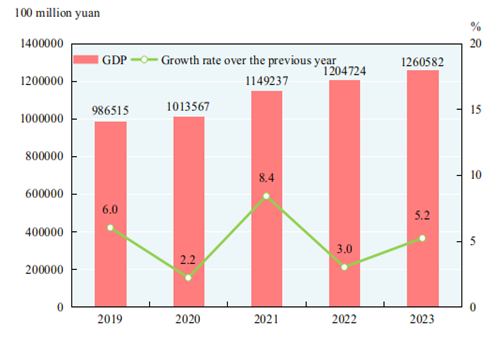
Figure 2: Shares of the Three Industries’ Value Added in GDP 2019-2023
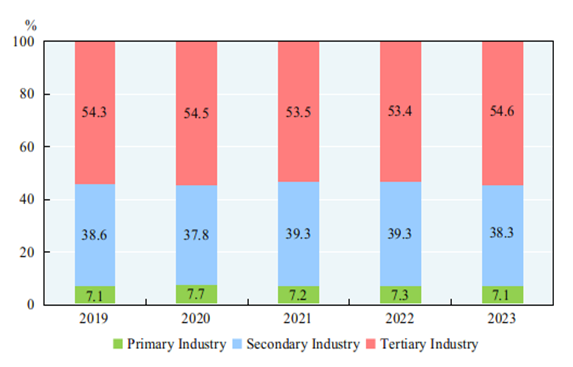
Figure 3: The Overall Labor Productivity 2019-2023
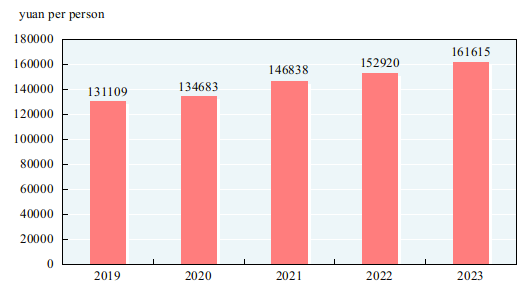
By the end of 2023, the total number of national population[5] reached 1,409.67 million, a decrease of 2.08 million over that at the end of 2022. Of this total, urban permanent residents numbered 932.67 million. There were 9.02 million births in 2023 with a crude birth rate of 6.39 per thousand; and there were 11.10 million deaths with a crude death rate of 7.87 per thousand. The natural growth rate was -1.48 per thousand.
Table 1: Population and Its Composition by the End of 2023
|
Item |
Population at Year-end (10,000 persons) |
Proportion (%) |
|
|
|
|
|
National Total |
140967 |
100.0 |
|
Of which: Urban |
93267 |
66.2 |
|
Rural |
47700 |
33.8 |
|
Of which: Male |
72032 |
51.1 |
|
Female |
68935 |
48.9 |
|
Of which: Aged 0-15 (under the age of 16)[6] |
24789 |
17.6 |
|
Aged 16-59 (under the age of 60) |
86481 |
61.3 |
|
Aged 60 and above |
29697 |
21.1 |
|
Of which: Aged 65 and above |
21676 |
15.4 |
|
|
|
|
At the end of 2023, the number of employed people in China was 740.41 million, and that in urban areas was 470.32 million, accounting for 63.5 percent of the total employed people. The newly increased employed people in urban areas[7] numbered 12.44 million in 2023, 0.38 million more than that of the previous year. The urban surveyed unemployment rate in 2023 averaged 5.2 percent. The urban surveyed unemployment rate at the year end was 5.1 percent. The total number of migrant workers[8] was 297.53 million, up by 0.6 percent over that of 2022. Specifically, the number of migrant workers who left their hometowns and worked in other places was 176.58 million, up by 2.7 percent, and those who worked in their own localities reached 120.95 million, down by 2.2 percent.
Figure 4:Newly Increased Employed People in Urban Areas 2019-2023
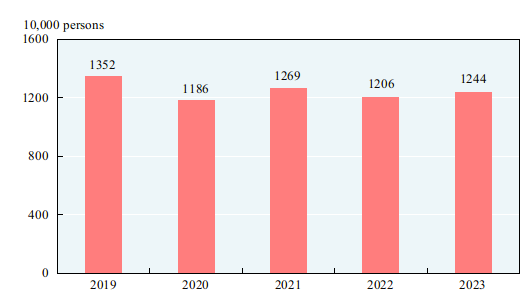
The consumer prices in 2023 went up by 0.2 percent over the previous year. The producer prices for industrial products went down by 3.0 percent and the purchasing prices for industrial producers down by 3.6 percent. The producer prices for farm products[9] dropped by 2.3 percent. In December, out of the 70 large and medium-sized cities, 20 cities experienced a year-on-year rise in sales prices of new commercial residential buildings, 2 cities maintained the same and 48 cities experienced a decline; one city experienced a year-on-year rise in sales prices of second-hand housing, and 69 cities experienced a decline.
Figure 5:Monthly Changes of Consumer Prices in 2023
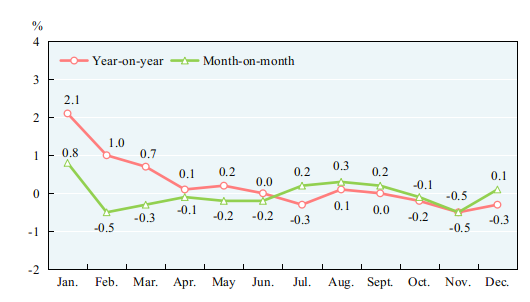
Table 2: Changes of Consumer Prices in 2023
Unit: %
|
Item |
National |
|
|
|
Urban |
Rural |
||
|
|
|
|
|
|
General level of consumer prices |
0.2 |
0.3 |
0.1 |
|
Of which: Food, tobacco and liquor |
0.3 |
0.4 |
0.1 |
|
Clothing |
1.0 |
1.1 |
0.6 |
|
Residence[10] |
0.0 |
0.0 |
0.0 |
|
Household facilities, articles and services |
0.1 |
0.1 |
-0.1 |
|
Transportation and telecommunication |
-2.3 |
-2.3 |
-2.4 |
|
Education, culture and recreation |
2.0 |
2.1 |
1.5 |
|
Health care and medical services |
1.1 |
1.1 |
1.3 |
|
Miscellaneous goods and services |
3.2 |
3.4 |
2.5 |
|
|
|
|
|
At the end of 2023, China’s foreign exchange reserves reached 3,238.0 billion US dollars, an increase of 110.3 billion US dollars compared with that at the end of 2022. The average exchange rate of the year was 7.0467 RMB to 1 USD dollar, depreciated by 4.5 percent over that of 2022.
Figure 6:Year-end China's Foreign Exchange Reserves 2019-2023
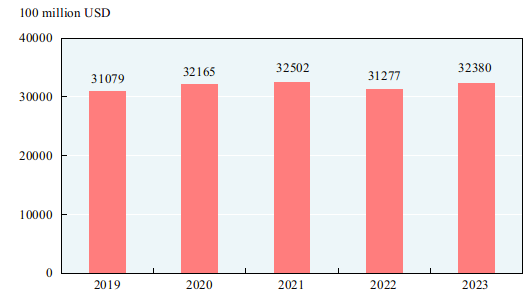
New growth drivers witnessed robust development. Among the industries above the designated size[11], the value added of the manufacture of equipment[12] was up by 6.8 percent over the previous year, accounting for 33.6 percent of that of all industrial enterprises above the designated size. The value added of the high technology manufacturing industry[13] increased by 2.7 percent, accounting for 15.7 percent of that of all industrial enterprises above the designated size. In 2023, the output of new energy vehicles reached 9.443 million, up by 30.3 percent over the previous year; that of solar cells (photovoltaic cells) was 0.54 billion kilowatts, up by 54.0 percent; that of service robots reached 7.833 million, up by 23.3 percent; and that of 3D printing devices totaled 2.789 million, up by 36.2 percent. Among the service enterprises above the designated size[14], the business revenue of the strategic emerging service industries[15] went up by 7.7 percent compared with the previous year. In 2023, the investment in high technology industries[16] increased by 10.3 percent over the previous year and the investment in technology transformation of manufacturing[17] grew by 3.8 percent. In 2023, the e-commerce transactions[18] reached 46,827.3 billion yuan, up by 9.4 percent over the previous year. The online retail sales[19] in 2023 reached 15,426.4 billion yuan, up by 11.0 percent over the previous year. In 2023, the number of newly established business entities was 32.73 million, with 0.027 million enterprises newly established per day on average.
Steady progress was made in the integrated development of urban and rural areas and coordinated regional development. By the end of 2023, the urbanization rate of permanent residents reached 66.16 percent, 0.94 percentage points higher than that at the end of 2022. By region[20], in 2023, the gross domestic product in the eastern areas was 65,208.4 billion yuan, an increase of 5.4 percent over the previous year; the central areas, 26,989.8 billion yuan, up by 4.9 percent; the western areas, 26,932.5 billion yuan, up by 5.5 percent; and the northeastern areas, 5,962.4 billion yuan, up by 4.8 percent. In 2023, the gross domestic product in Beijing-Tianjin-Hebei Region reached 10,444.2 billion yuan, up by 5.1 percent over the previous year; that in the Yangtze River Economic Belt, 58,427.4 billion yuan, up by 5.5 percent; and that in the Yangtze River Delta, 30,504.5 billion yuan, up by 5.7 percent. Major regional strategies such as the construction of Guangdong-Hong Kong-Macao Greater Bay Areas, and the ecological protection and high-quality development of the Yellow River Basin were further advanced.
Figure 7:Year-end Urbanization Rates of Permanent Residents 2019-2023
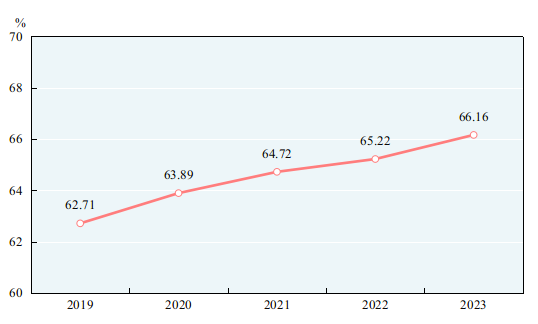
Green and low-carbon transformation was further promoted. The national carbon dioxide emissions per 10,000 yuan worth of GDP[21] in 2023 remained the same as that of the previous year. In 2023, the electricity generated by clean energy such as hydropower, nuclear power, wind power and solar power was 3,190.6 billion kilowatts-hours, up by 7.8 percent over the previous year. Of the monitored 339 cities at prefecture level and above, 59.9 percent reached the air quality standard and 40.1 percent failed. Of the 3,641 sections under the national monitoring program for surface water, 89.4 percent were of fairly clean water quality (Grade I to III), 8.4 percent were Grade IV, 1.5 percent were Grade V and 0.7 percent were worse than Grade V national standard.
II. Agriculture
In 2023, the sown area of grain was 118.97 million hectares, an increase of 0.64 million hectares compared with that in 2022. Of this total, the sown area of rice was 28.95 million hectares, a decrease of 0.50 million hectares; the sown area of wheat was 23.63 million hectares, an increase of 0.11 million hectares; the sown area of corn was 44.22 million hectares, an increase of 1.15 million hectares; the sown area of soybean was 10.47 million hectares, an increase of 0.23 million hectares. The sown area of cotton was 2.79 million hectares, a decrease of 0.21 million hectares. The sown area of oil-bearing crops was 13.92 million hectares, an increase of 0.78 million hectares; the sown area of sugar crops was 1.42 million hectares, a decrease of 0.03 million hectares.
The total output of grain in 2023 was 695.41 million tons, an increase of 8.88 million tons over the previous year, up by 1.3 percent. Of this total, the output of summer crops was 146.15 million tons, down by 0.8 percent, that of the early rice was 28.34 million tons, up by 0.8 percent, and that of autumn grain was 520.92 million tons, up by 1.9 percent. The output of cereal in 2023 was 641.43 million tons, up by 1.3 percent over 2022, among which the output of rice was 206.60 million tons, down by 0.9 percent; that of wheat was 136.59 million tons, down by 0.8 percent; and that of corn was 288.84 million tons, up by 4.2 percent. The output of soybean was 20.84 million tons, up by 2.8 percent.
Figure 8: Output of Grain 2019-2023
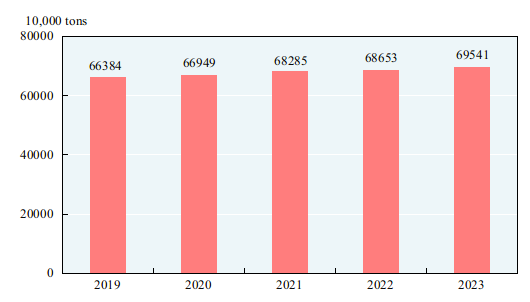
In 2023, the output of cotton was 5.62 million tons, down by 6.1 percent over the previous year, that of oil-bearing crops was 38.64 million tons, up by 5.7 percent, that of sugar crops was 115.04 million tons, up by 2.4 percent, and that of tea was 3.55 million tons, up by 6.1 percent.
The total output of pork, beef, mutton and poultry in 2023 was 96.41 million tons, up by 4.5 percent over the previous year. Of this total, the output of pork was 57.94 million tons, up by 4.6 percent; that of beef was 7.53 million tons, up by 4.8 percent; that of mutton was 5.31 million tons, up by 1.3 percent; and that of poultry was 25.63 million tons, up by 4.9 percent. The total output of eggs was 35.63 million tons, up by 3.1 percent. The output of milk was 41.97 million tons, up by 6.7 percent. At the end of the year, 434.22 million pigs were registered in the total stocks, down by 4.1 percent compared with that at the end of 2022, and 726.62 million pigs were slaughtered, up by 3.8 percent over the previous year.
The total output of aquatic products in 2023 was 71.00 million tons, up by 3.4 percent over the previous year. Of this total, the output of cultured aquatic products was 58.12 million tons, up by 4.4 percent; and that of fished aquatic products was 12.88 million tons, down by 1.0 percent.
The total production of timber in 2023 reached 119.44 million cubic meters, down by 2.0 percent over the previous year.
In 2023, the number of high-standard farmland newly developed and upgraded was 5.74 million hectares and 1.64 million hectares of farmland was newly equipped with water-saving irrigation systems.
III. Industry and Construction
In 2023, the total value added of the industrial sector was 39,910.3 billion yuan, up by 4.2 percent over the previous year. The value added of industrial enterprises above the designated size increased by 4.6 percent. Of the industrial enterprises above the designated size, in terms of ownership, the value added of the state-holding enterprises was up by 5.0 percent, that of the share-holding enterprises up by 5.3 percent, that of the enterprises funded by foreign investors and investors from Hong Kong, Macao and Taiwan up by 1.4 percent and that of private enterprises up by 3.1 percent. In terms of sectors, the value added of the mining industry was up by 2.3 percent, that of manufacturing up by 5.0 percent and that of production and supply of electricity, heat power, gas and water up by 4.3 percent.
Figure 9: Value Added and Growth Rates of Industrial Enterprises 2019-2023
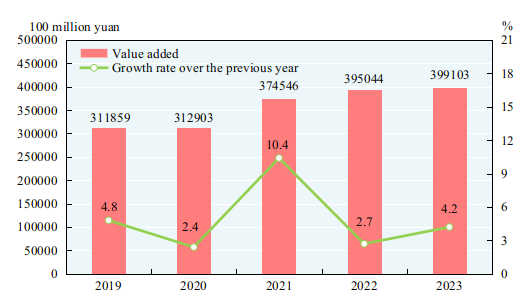
In 2023, of the industrial enterprises above the designated size, the value added for processing of food from agricultural and sideline products was up by 0.2 percent over the previous year; for textile industry down by 0.6 percent; for manufacture of raw chemical materials and chemical products up by 9.6 percent; for manufacture of non-metallic mineral products down by 0.5 percent; for smelting and pressing of ferrous metals up by 7.1 percent; for manufacture of general purpose machinery up by 2.0 percent; for manufacture of special purpose machinery up by 3.6 percent; for manufacture of automobiles up by 13.0 percent; for manufacture of electrical machinery and apparatus up by 12.9 percent; for manufacture of computers, communication equipment and other electronic equipment up by 3.4 percent; for production and supply of electricity and heat power up by 4.3 percent.
Table 3: Output of Major Industrial Products and Growth Rates of the Industrial Enterprises above the Designated Size in 2023[22]
|
Product |
Unit |
Output |
Increase over 2022 (%) |
|
|
|
|
|
|
Yarn |
10000 tons |
2234.2 |
-2.2 |
|
Cloth |
100 million meters |
294.9 |
-4.8 |
|
Chemical fiber |
10000 tons |
7127.0 |
10.3 |
|
Refined sugar (final product) |
10000 tons |
1270.6 |
-13.2 |
|
Cigarettes |
100 million |
24427.5 |
0.4 |
|
Color TV sets |
10000 |
19339.6 |
-1.3 |
|
Household refrigerators |
10000 |
9632.3 |
14.5 |
|
Air conditioners |
10000 |
24487.0 |
13.5 |
|
Crude steel |
10000 tons |
101908.1 |
0.0 |
|
Rolled steel[23] |
10000 tons |
136268.2 |
5.2 |
|
Ten kinds of nonferrous metals |
10000 tons |
7469.8 |
7.1 |
|
Of which: Refined copper (copper) |
10000 tons |
1298.8 |
13.5 |
|
Aluminum electrolyze |
10000 tons |
4159.4 |
3.7 |
|
Cement |
100 million tons |
20.2 |
-0.7 |
|
Sulfuric acid (100%) |
10000 tons |
9580.0 |
3.4 |
|
Caustic soda (100%) |
10000 tons |
4101.4 |
3.5 |
|
Ethylene |
10000 tons |
3189.9 |
6.0 |
|
Chemical fertilizer(100 percent equivalent) |
10000 tons |
5713.6 |
5.0 |
|
Power generation equipment |
10000 kilowatts |
23442.7 |
28.5 |
|
Motor vehicles |
10000 |
3011.3 |
9.3 |
|
Of which: New energy vehicles |
10000 |
944.3 |
30.3 |
|
Large and medium tractors |
10000 |
38.0 |
-7.2 |
|
Integrated circuits |
100 million pieces |
3514.4 |
6.9 |
|
Program-controlled switchboards |
10000 lines |
507.0 |
-42.6 |
|
Mobile telephones |
10000 |
156642.2 |
6.9 |
|
Micro computer equipment |
10000 |
33056.9 |
-17.4 |
|
Industrial robots |
10000 sets |
43.0 |
-2.2 |
|
Ultra-clear glass for solar industry |
10000 square meters |
159264.8 |
58.6 |
|
Charging piles |
10000 |
287.8 |
36.9 |
|
|
|
|
|
In 2023, the profits made by industrial enterprises above the designated size were 7,685.8 billion yuan, down by 2.3 percent over the previous year. By ownership, the profits of state-holding enterprises were 2,262.3 billion yuan, down by 3.4 percent over the previous year; those of share-holding enterprises were 5,677.3 billion yuan, down by 1.2 percent; those of enterprises funded by foreign investors and investors from Hong Kong, Macao and Taiwan were 1,797.5 billion yuan, down by 6.7 percent; and those of private enterprises were 2,343.8 billion yuan, up by 2.0 percent. In terms of different sectors, the profits of mining were 1,239.2 billion yuan, down by 19.7 percent over the previous year; those of manufacturing were 5,764.4 billion yuan, down by 2.0 percent; and those of the production and supply of electricity, heat power, gas and water were 682.2 billion yuan, up by 54.7 percent. The cost for per-hundred-yuan business revenue of the industrial enterprises above the designated size was 84.76 yuan, 0.04 yuan more than that of 2022; the profit rate of the business revenue was 5.76 percent, 0.20 percentage points down. By the end of 2023, the asset-liability ratio of industrial enterprises above the designated size was 57.1 percent, 0.1 percentage points lower than that at the end of 2022. The capacity utilization rate[24] of industrial enterprises above the designated size was 75.1 percent in 2023.
According to preliminary estimates, the total primary energy output in 2023 was 4.83 billion tons of standard coal equivalent, up by 4.2 percent over that of the previous year.
Table 4: Output of Major Energy Products and Growth Rates in 2023
|
Product |
Unit |
Output |
Increase over 2022 (%) |
|
|
|
|
|
|
Coal |
100 million tons |
47.1 |
3.4 |
|
Crude petroleum oil |
10000 tons |
20902.6 |
2.1 |
|
Natural gas |
100 million cubic meters |
2324.3 |
5.6 |
|
Electricity |
100 million kilowatt-hours |
94564.4 |
6.9 |
|
Of which:Thermal power[25] |
100 million kilowatt-hours |
62657.4 |
6.4 |
|
Hydropower |
100 million kilowatt-hours |
12858.5 |
-4.9 |
|
Nuclear-power |
100 million kilowatt-hours |
4347.2 |
4.1 |
|
Wind power |
100 million kilowatt-hours |
8858.7 |
16.2 |
|
Solar power |
100 million kilowatt-hours |
5841.5 |
36.7 |
|
|
|
|
|
By the end of 2023, the installed power generation capacity was 2,919.65 million kilowatts, up by 13.9 percent over that at the end of 2022, among which[26] the installed thermal power generation capacity was 1,390.32 million kilowatts, up by 4.1 percent; the installed hydropower generation capacity was 421.54 million kilowatts, up by 1.8 percent; the installed nuclear power generation capacity was 56.91 million kilowatts, up by 2.4 percent; the installed grid-connected wind power generation capacity was 441.34 million kilowatts, up by 20.7 percent and the installed grid-connected solar power generation capacity was 609.49 million kilowatts, up by 55.2 percent.
In 2023, the value added of construction enterprises was 8,569.1 billion yuan, up by 7.1 percent over the previous year. The profits made by construction enterprises qualified for general contracts and specialized contracts reached 832.6 billion yuan, up by 0.2 percent over the previous year[27], of which the profits made by state-holding enterprises were 401.9 billion yuan, up by 4.3 percent.
Figure 10: Value Added and Growth Rates of Construction Industry 2019-2023

IV. Service Sector
In 2023, the value added of the wholesale and retail trades was 12,307.2 billion yuan, up by 6.2 percent over the previous year; that of transport, storage and post was 5,782.0 billion yuan, up by 8.0 percent; that of hotels and catering services was 2,102.4 billion yuan, up by 14.5 percent; that of financial intermediation was 10,067.7 billion yuan, up by 6.8 percent; that of real estate was 7,372.3 billion yuan, down by 1.3 percent; that of information transmission, software and information technology services was 5,519.4 billion yuan, up by 11.9 percent; and that of leasing and business services was 4,434.7 billion yuan, up by 9.3 percent. The business revenue of service enterprises above the designated size grew by 8.3 percent over the previous year, and the total profits increased by 26.8 percent.
Figure 11: Value Added and Growth Rates of Service Sector 2019-2023
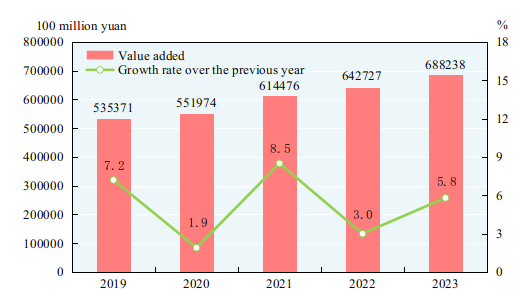
The total freight traffic[28] in 2023 reached 55.7 billion tons, up by 8.1 percent over the previous year. The freight flows were 24,771.3 billion ton-kilometers, up by 6.3 percent. The volume of freight handled by ports totaled 17.0 billion tons, up by 8.2 percent over the previous year, of which the freight for foreign trade was 5.0 billion tons, up by 9.5 percent. Container shipping of ports reached 310.34 million standard containers, up by 4.9 percent.
Table 5: Freight Traffic by All Means of Transportation and Growth Rates in 2023
|
Item |
Unit |
Volume |
Increase over 2022(%) |
|
|
|
|
|
|
Total freight traffic |
100 million tons |
556.8 |
8.1 |
|
Railways |
100 million tons |
50.1 |
1.5 |
|
Highways |
100 million tons |
403.4 |
8.7 |
|
Waterways |
100 million tons |
93.7 |
9.5 |
|
Civil aviation |
10000 tons |
735.4 |
21.0 |
|
Pipelines |
100 million tons |
9.5 |
7.5 |
|
Freight flows |
100 million ton-kilometers |
247712.7 |
6.3 |
|
Railways |
100 million ton-kilometers |
36437.6 |
1.5 |
|
Highways |
100 million ton-kilometers |
73950.2 |
6.9 |
|
Waterways |
100 million ton-kilometers |
129951.5 |
7.4 |
|
Civil aviation |
100 million ton-kilometers |
283.6 |
11.6 |
|
Pipelines |
100 million ton-kilometers |
7089.8 |
3.8 |
|
|
|
|
|
In 2023, the total passenger traffic was 9.3 billion person-times, up by 66.5 percent over 2022, and the passenger flows were 2,861.0 billion person-kilometers, up by 121.4 percent.
Table 6: Passenger Traffic by All Means of Transportation and Growth Rates in 2023
|
Item |
Unit |
Volume |
Increase over 2022(%) |
|
|
|
|
|
|
Total passenger traffic |
100 million person-times |
93.0 |
66.5 |
|
Railways |
100 million person-times |
38.5 |
130.4 |
|
Highways |
100 million person-times |
45.7 |
28.9 |
|
Waterways |
100 million person-times |
2.6 |
121.6 |
|
Civil aviation |
100 million person-times |
6.2 |
146.1 |
|
Passenger flows |
100 million person-kilometers |
28609.6 |
121.4 |
|
Railways |
100 million person-kilometers |
14729.4 |
123.9 |
|
Highways |
100 million person-kilometers |
3517.6 |
46.1 |
|
Waterways |
100 million person-kilometers |
53.8 |
137.9 |
|
Civil aviation |
100 million person-kilometers |
10308.8 |
163.4 |
|
|
|
|
|
The total number of motor vehicles for civilian use reached 336.18 million (including 7.06 million tri-wheel motor vehicles and low-speed trucks) by the end of 2023, up by 17.14 million over that at the end of 2022, of which the privately-owned vehicles numbered 294.27 million, an increase of 15.53 million. The total number of cars for civilian use was 186.68 million, an increase of 9.28 million, of which the privately-owned cars numbered 175.41 million, an increase of 8.56 million.
In 2023, the volume of postal and delivery services[29] totaled 162.5 billion, up by 16.8 percent over the previous year. The number of mail delivery was 0.97 billion; that of parcel delivery was 0.02 billion; and that of express delivery was 132.07 billion with a revenue reaching 1,207.4 billion yuan. The turnover of telecommunication services[30] in 2023 totaled 1,832.7 billion yuan, up by 16.8 percent over the previous year. By the end of 2023, there were 11.62 million mobile phone base stations[31], among which the number of 4G base stations reached 6.29 million and that of 5G base stations was 3.38 million. There were 1,899.92 million phone subscribers in China, of whom 1,726.60 million were mobile phone subscribers. The mobile phone coverage was 122.5 sets per 100 persons. The number of fixed broadband internet users[32] reached 636.31 million, an increase of 46.66 million over that at the end of the previous year. Of this total, users of broadband with the speed of 100M and above[33] amounted to 601.36 million, an increase of 47.56 million. Users of cellular internet of things terminals[34] totaled 2.332 billion, an increase of 0.488 billion. The number of internet users was 1.092 billion, 1.091 billion of which were mobile internet surfers. The coverage of internet was 77.5 percent, and 66.5 percent in rural areas. The mobile internet traffic in 2023 was 301.5 billion gigabytes, up by 15.2 percent over the previous year. Software revenue of software and information technology services industry[35] was 12,325.8 billion yuan, up by 13.4 percent over that of the previous year.
Figure 12: Express Delivery and Growth Rates 2019-2023
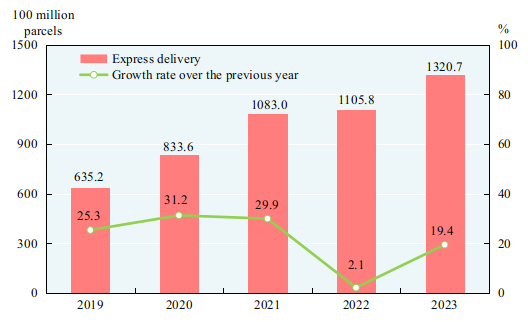
Figure 13: Year-end Number of Fixed Broadband Internet Users
2019-2023
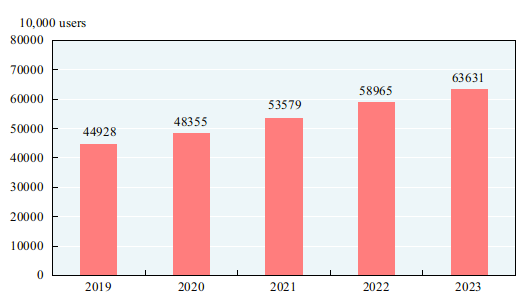
V. Domestic Trade
In 2023, the total retail sales of consumer goods reached 47,149.5 billion yuan, up by 7.2 percent over the previous year. An analysis on different areas showed that the retail sales of consumer goods in urban areas stood at 40,749.0 billion yuan, up by 7.1 percent, and that in rural areas reached 6,400.5 billion yuan, up by 8.0 percent. Grouped by consumption patterns, the retail sales of commodities were 41,860.5 billion yuan, up by 5.8 percent, and the income of catering industry was 5,289.0 billion yuan, up by 20.4 percent. The retail sales of services[36] increased by 20.0 percent over the previous year.
Figure 14: Total Retail Sales of Consumer Goods and Growth Rates 2019-2023
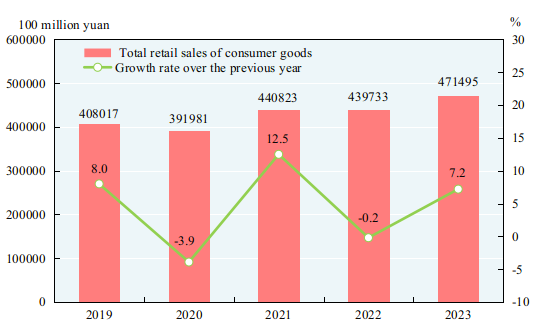
Of the total retail sales of commodities by enterprises above the designated size, the retail sales for grain, oil and food went up by 5.2 percent over the previous year; beverage up by 3.2 percent; tobacco and liquor up by 10.6 percent; clothes, shoes, hats and textiles up by 12.9 percent; cosmetics up by 5.1 percent; gold, silver and jewelry up by 13.3 percent; daily necessities up by 2.7 percent; household appliances and audio-video equipment up by 0.5 percent; traditional Chinese and western medicines up by 5.1 percent; cultural and office appliances down by 6.1 percent; furniture up by 2.8 percent; telecommunication equipment up by 7.0 percent; petroleum and petroleum products up by 6.6 percent; motor vehicles up by 5.9 percent; and building and decoration materials down by 7.8 percent.
In 2023, the online retail sales of physical goods were 13,017.4 billion yuan, up by 8.4 percent over the previous year on a comparable basis, accounting for 27.6 percent of the total retail sales of consumer goods.
VI. Investment in Fixed Assets
The total investment in fixed assets of the country in 2023 was 50,970.8 billion yuan, up by 2.8 percent over the previous year[37]. The investment in fixed assets (excluding rural households) was 50,303.6 billion yuan, up by 3.0 percent. Of the investment in fixed assets (excluding rural households), by regions[38], the investment in eastern areas was up by 4.4 percent, central areas up by 0.3 percent, western areas up by 0.1 percent, and northeastern areas down by 1.8 percent.
Of the investment in fixed assets (excluding rural households), the investment in the primary industry was 1,008.5 billion yuan, down by 0.1 percent over the previous year; that in the secondary industry was 16,213.6 billion yuan, up by 9.0 percent; and that in the tertiary industry was 33,081.5 billion yuan, up by 0.4 percent. The investment in infrastructure[39] increased by 5.9 percent. The investment in social sector[40] increased by 0.5 percent.The private investment in fixed assets[41] was 25,354.4 billion yuan, down by 0.4 percent; among which, the private investment in manufacturing increased by 9.4 percent and in infrastructure increased by 14.2 percent.
Figure 15: Shares of Investment in Fixed Assets (Excluding Rural Households) of the Three Industries in 2023
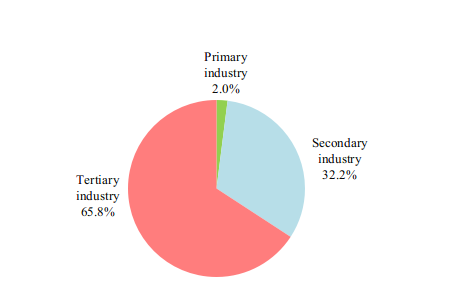
Table 7: Growth Rates of Investment in Fixed Assets (Excluding Rural Households) by Sectors in 2023
|
Sector |
Increase over 2022 (%) |
Sector |
Increase over 2022 (%) |
|
|
|
|
|
|
Total |
3.0 |
Financial Intermediation |
-11.9 |
|
Agriculture, Forestry, Animal Husbandry and Fishery |
1.2 |
Real Estate[43] |
-8.1 |
|
Mining |
2.1 |
Leasing and Business Services |
9.9 |
|
Manufacturing |
6.5 |
Scientific Research and Technical Services |
18.1 |
|
Production and Supply of Electricity, Heat Power, Gas and Water |
23.0 |
Water Conservancy, Environment and Public Facilities Management |
0.1 |
|
Construction |
22.5 |
Services to Households, Repair and Other Services |
15.8 |
|
Wholesale and Retail Trades |
-0.4 |
Education |
2.8 |
|
Transport, Storage and Post |
10.5 |
Health and Social Service |
-3.8 |
|
Hotels and Catering Services |
8.2 |
Culture, Sports and Entertainment |
2.6 |
|
Information Transmission, Software and Information Technology Services |
13.8 |
Public Management, Social Security and Social Organizations |
-37.0 |
|
|
|
|
|
Table 8: Newly Increased Production and Operation Capacity through Fixed Assets Investment in 2023
|
Item |
Unit |
Volume |
|
|
|
|
|
Newly increased power transformer equipment with a capacity of over 220 kilovolts |
10,000 kilovolt-amperes |
25656 |
|
New railways put into operation |
kilometer |
3637 |
|
Of which:high-speed railways |
kilometer |
2776 |
|
Extended or new double-track railways put into operation |
kilometer |
3351 |
|
Electrified railways put into operation |
kilometer |
4463 |
|
Length of new and rebuilt highways |
kilometer |
7498 |
|
New throughput capacity of berths for over 10,000-tonnage ships |
10,000 tons/year |
32529 |
|
New civil transportation airports |
- |
5 |
|
New lines of optical-fiber cables |
10,000 km |
474 |
|
|
|
|
In 2023, the investment in real estate development was 11,091.3 billion yuan, down by 9.6 percent over the previous year[43]. Of this total, the investment in residential buildings reached 8,382.0 billion yuan, a decrease of 9.3 percent, that in office buildings was 453.1 billion yuan, down by 9.4 percent, and that in buildings for commercial business was 805.5 billion yuan, down by 16.9 percent. In 2023, the floor space of newly built commercial buildings sold[44] was 1,117.35 million square meters. The floor space of second-hand housing online transactions[45] reached 708.82 million square meters. The floor space of newly built commercial buildings for sale was 672.95 million square meters at the end of 2023, among which the floor space of the commercial residential buildings for sale was 331.19 million square meters.
Table 9: Main Indicators for Real Estate Development and Sales and Growth Rates in 2023
|
Item |
Unit |
Volume |
Increase over 2022 (%) |
|
|
|
|
|
|
Investment in real estate development |
100 million RMB |
110913 |
-9.6 |
|
Of which: residential buildings |
100 million RMB |
83820 |
-9.3 |
|
Floor space of buildings under construction |
10000 square meters |
838364 |
-7.2 |
|
Of which: residential buildings |
10000 square meters |
589884 |
-7.7 |
|
Floor space of buildings newly started |
10000 square meters |
95376 |
-20.4 |
|
Of which: residential buildings |
10000 square meters |
69286 |
-20.9 |
|
Floor space of buildings completed |
10000 square meters |
99831 |
17.0 |
|
Of which: residential buildings |
10000 square meters |
72433 |
17.2 |
|
Floor space of newly built commercial buildings sold |
10000 square meters |
111735 |
-8.5 |
|
Of which: residential buildings |
10000 square meters |
94796 |
-8.2 |
|
Funds for investment this year of real estate development enterprises |
100 million RMB |
127459 |
-13.6 |
|
Of which: domestic loans |
100 million RMB |
15595 |
-9.9 |
|
individual mortgage |
100 million RMB |
21489 |
-9.1 |
|
|
|
|
|
In 2023, 1.59 million housing units were started to be rebuilt in rundown urban areas nationwide and 1.93 million were basically completed. There were 2.13 million units of government-subsidized rental housing that were started to be built or made available. Renovation began on 53.7 thousand old urban residential communities, benefiting 8.97 million households.
VII. Foreign Economic Relations
The total value of imports and exports of goods in 2023 reached 41,756.8 billion yuan, up by 0.2 percent over that of the previous year. Of this total, the value of goods exported was 23,772.6 billion yuan, up by 0.6 percent; the value of goods imported was 17,984.2 billion yuan, down by 0.3 percent. The surplus of trade in goods reached 5,788.3 billion yuan, up by 193.8 billion yuan over that of the previous year. The total value of imports and exports between China and countries along the Belt and Road[46] was 19,471.9 billion yuan, an increase of 2.8 percent over that of the previous year. Of this total, the value of goods exported was 10,731.4 billion yuan, up by 6.9 percent; the value of goods imported was 8,740.5 billion yuan, down by 1.9 percent. The total value of imports and exports between China and other Regional Comprehensive Economic Partnership (RCEP) member countries[47] was 12,596.7 billion yuan, down by 1.6 percent over that of the previous year. The total value of imports and exports by private enterprises was 22,360.1 billion yuan, up by 6.3 percent over that of the previous year, accounting for 53.5 percent of the total value of imports and exports.
Figure 16: Total Value of Imports and Exports of Goods 2019-2023
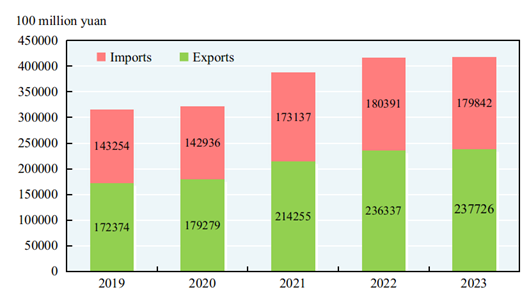
Table 10: Total Value and Growth Rates of Imports and Exports of Goods in 2023
|
Item |
Value (100 million yuan) |
Increase over 2022 (%) |
|
|
|
|
|
Total value of import and export of goods |
417568 |
0.2 |
|
Exports |
237726 |
0.6 |
|
Of which: General trade |
153530 |
2.5 |
|
Processing trade |
49062 |
-9.0 |
|
Of which: Mechanical and electronic products |
139196 |
2.9 |
|
High & new technology products |
59279 |
-5.8 |
|
Imports |
179842 |
-0.3 |
|
Of which: General trade |
117042 |
1.3 |
|
Processing trade |
27061 |
-11.3 |
|
Of which: Mechanical and electronic products |
65363 |
-5.5 |
|
High & new technology products |
47916 |
-5.2 |
|
Trade surplus in goods |
57883 |
3.5 |
|
|
|
|
Table 11: Main Export Commodities in Volume and Value and the Growth Rates in 2023
|
Item |
Unit |
Volume |
Increase over 2022 (%) |
Value (100 million yuan) |
Increase over 2022 (%) |
|
|
|
|
|
|
|
|
Rolled steel |
10000 tons |
9026 |
36.2 |
5929 |
-3.4 |
|
Textile yarns and textile articles |
— |
— |
— |
9454 |
-3.1 |
|
Clothes and clothing accessories |
— |
— |
— |
11206 |
-2.8 |
|
Footwear |
10000 pairs |
891424 |
-2.5 |
3470 |
-8.0 |
|
Furniture and parts |
— |
— |
— |
4517 |
0.2 |
|
Luggage and similar containers |
10000 tons |
331 |
13.5 |
2512 |
9.3 |
|
Toys |
— |
— |
— |
2858 |
-7.4 |
|
Plastic articles |
— |
— |
— |
7090 |
1.4 |
|
Integrated circuits |
100 million pieces |
2678 |
-1.8 |
9568 |
-5.0 |
|
Automatic data processing machines and components |
— |
— |
— |
13187 |
-15.8 |
|
Mobile phones |
10000 sets |
80213 |
-2.0 |
9797 |
2.9 |
|
Containers |
10000 units |
231 |
-27.9 |
581 |
-39.8 |
|
Liquid crystal display modules |
10000 units |
168929 |
2.9 |
1873 |
3.8 |
|
Motor vehicles (including chassis) |
10000 sets |
522 |
57.4 |
7165 |
76.8 |
|
|
|
|
|
|
|
Table 12: Main Import Commodities in Volume and Value and the Growth Rates in 2023
|
Item |
Unit |
Volume |
Increase over 2022 (%) |
Value (100 million yuan) |
Increase over 2022 (%) |
|
|
|
|
|
|
|
|
Soybean |
10000 tons |
9941 |
11.4 |
4199 |
4.8 |
|
Edible vegetable oil |
10000 tons |
981 |
51.4 |
734 |
21.1 |
|
Iron ore and concentrate |
10000 tons |
117906 |
6.6 |
9418 |
11.2 |
|
Coal and lignite |
10000 tons |
47442 |
61.8 |
3723 |
30.2 |
|
Crude oil |
10000 tons |
56399 |
11.0 |
23733 |
-2.6 |
|
Petroleum products refined |
10000 tons |
4769 |
80.3 |
1965 |
50.0 |
|
Natural gas |
10000 tons |
11997 |
9.9 |
4523 |
-3.4 |
|
Plastics in primary forms |
10000 tons |
2960 |
-3.2 |
3182 |
-14.8 |
|
Paper pulp |
10000 tons |
3666 |
25.7 |
1665 |
11.6 |
|
Rolled steel |
10000 tons |
765 |
-27.6 |
891 |
-21.5 |
|
Unwrought copper and its alloys |
10000 tons |
550 |
-6.3 |
3356 |
-6.9 |
|
Integrated circuits |
100 million pieces |
4796 |
-10.8 |
24591 |
-10.6 |
|
Motor vehicles (including chassis) |
10000 sets |
80 |
-8.9 |
3321 |
-5.8 |
|
|
|
|
|
|
|
Table 13: Imports and Exports of Goods by Major Countries and Regions, the Growth Rates and Proportions in 2023
|
Country or region |
Exports (100 million yuan) |
Increase over 2022 (%) |
Proportion of the total (%) |
Imports (100 million yuan) |
Increase over 2022 (%) |
Proportion of the total (%) |
|
|
|
|
|
|
|
|
|
ASEAN |
36817 |
0.0 |
15.5 |
27309 |
0.4 |
15.2 |
|
European Union |
35226 |
-5.3 |
14.8 |
19833 |
4.6 |
11.0 |
|
United States |
35198 |
-8.1 |
14.8 |
11528 |
-1.8 |
6.4 |
|
Japan |
11076 |
-3.5 |
4.7 |
11309 |
-7.9 |
6.3 |
|
Republic of Korea |
10467 |
-2.2 |
4.4 |
11381 |
-13.9 |
6.3 |
|
Hong Kong, China |
19333 |
-1.3 |
8.1 |
958 |
84.3 |
0.5 |
|
Taiwan, China |
4819 |
-11.1 |
2.0 |
14033 |
-10.5 |
7.8 |
|
Russia |
7823 |
53.9 |
3.3 |
9093 |
18.6 |
5.1 |
|
Brazil |
4159 |
1.0 |
1.7 |
8625 |
18.4 |
4.8 |
|
India |
8279 |
6.5 |
3.5 |
1301 |
12.2 |
0.7 |
|
South Africa |
1661 |
4.4 |
0.7 |
2245 |
3.7 |
1.2 |
|
|
|
|
|
|
|
|
The total value of imports and exports of services in 2023 was 6,575.4 billion yuan, up by 10.0 percent over that of the previous year. The export value of services was 2,685.7 billion yuan, down by 5.8 percent. The import value of services was 3,889.8 billion yuan, up by 24.4 percent. The trade deficit in imports and exports of services was 1,204.1 billion yuan.
The year 2023 witnessed the establishment of 53,766 enterprises with foreign direct investment, up by 39.7 percent over that of the previous year, and the foreign direct investment actually utilized totaled 1,133.9 billion yuan, down by 8.0 percent, or 163.3 billion US dollars, down by 13.7 percent. Specifically, there were 13,649 newly established enterprises with direct investment from countries along the Belt and Road (including the investment in China via free ports), up by 82.7 percent; and the foreign capital directly invested in China reached 122.1 billion yuan, down by 11.4 percent, or 17.6 billion US dollars, down by 16.7 percent. In 2023, the foreign investment actually utilized by high technology industry reached 423.3 billion yuan, down by 4.9 percent, or 61.0 billion US dollars, down by 10.8 percent.
Table 14: Total Value of Foreign Direct Investment and the Growth Rates in 2023
|
|
Sector |
Enterprises |
Increase over 2022 (%) |
Actually Utilized Value (100 million yuan) |
Increase over 2022 (%) |
|
|
|
|
|
|
|
|
Total |
|
53766 |
39.7 |
11339 |
-8.0 |
|
Of which: |
Agriculture, Forestry, Animal Husbandry and Fishery |
418 |
-0.5 |
51 |
-36.8 |
|
|
Manufacturing |
3624 |
1.5 |
3179 |
-1.8 |
|
|
Production and Supply of Electricity, Heat Power, Gas and Water |
568 |
8.6 |
319 |
15.6 |
|
|
Transport, Storage and Post |
867 |
44.0 |
149 |
-57.2 |
|
|
Information Transmission, Software and Information Technology Services |
3764 |
23.0 |
1134 |
-26.7 |
|
|
Wholesale and Retail |
18010 |
65.3 |
690 |
-28.2 |
|
|
Real Estate |
684 |
17.7 |
810 |
-11.4 |
|
|
Leasing and Business Services |
10673 |
42.8 |
1819 |
-15.4 |
|
|
Services to Households, Repair and Other Services |
726 |
76.6 |
34 |
77.7 |
|
|
|
|
|
|
|
In 2023, the non-financial outbound direct investment reached 917.0 billion yuan, up by 16.7 percent over that of the previous year, or 130.1 billion US dollars, up by 11.4 percent. Of this total, that to countries along the Belt and Road reached 224.1 billion yuan, up by 28.4 percent, or 31.8 billion US dollars, up by 22.6 percent.
Table 15: Total Value and Growth Rates of Non-financial Outbound Direct Investment in 2023
|
|
Sector |
Value (100 million US dollars) |
Increase over 2022 (%) |
|
|
|
|
|
|
Total |
|
1301 |
11.4 |
|
Of which: |
Agriculture, Forestry, Animal Husbandry and Fishery |
8 |
-3.6 |
|
|
Mining |
70 |
39.0 |
|
|
Manufacturing |
279 |
29.0 |
|
|
Production and Supply of Electricity, Heat Power, Gas and Water |
31 |
-12.5 |
|
|
Construction |
67 |
5.1 |
|
|
Wholesale and Retail |
292 |
38.6 |
|
|
Transport, Storage and Post |
65 |
42.3 |
|
|
Information Transmission, Software and Information Technology Services |
49 |
-10.9 |
|
|
Real Estate |
10 |
-57.4 |
|
|
Leasing and Business Services |
337 |
-13.0 |
|
|
|
|
|
In 2023, the accomplished business revenue through contracted overseas engineering projects was 1,133.9 billion yuan, up by 8.8 percent over that of the previous year, or 160.9 billion US dollars, up by 3.8 percent. Specifically, the accomplished business revenue from countries along the Belt and Road was 132.1 billion US dollars, up by 4.8 percent, accounting for 82.1 percent of the accomplished business revenue through contracted overseas engineering projects. The number of labor forces sent abroad through overseas labor contracts was 0.35 million.
VIII. Finance and Financial Intermediation
The national general public budget revenue reached 21,678.4 billion yuan in 2023, up by 6.4 percent over that of the previous year, of which tax revenue amounted to 18,112.9 billion yuan, up by 8.7 percent. The national general public budget expenditure reached 27,457.4 billion yuan, up by 5.4 percent over that of the previous year. The newly added tax refunds, as well as tax and fee cuts and deferrals exceeded 2.2 trillion yuan in 2023.
Figure 17: National General Public Budget Revenue 2019-2023
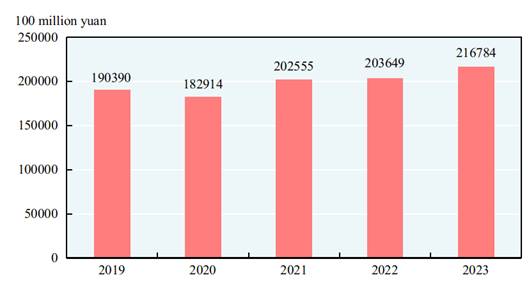
Note: Data for general public budget revenue from 2019 to 2022 as shown in the figure were final accounts and that of 2023 was the executive accounts.
By the end of 2023, money supply of broad sense (M2) was 292.3 trillion yuan, an increase of 9.7 percent over that by the end of the previous year. Money supply of narrow sense (M1) was 68.1 trillion yuan, up by 1.3 percent. Cash in circulation (M0) was 11.3 trillion yuan, up by 8.3 percent.
In 2023, the aggregate financing to the real economy (AFRE) (flow)[48] reached 35.6 trillion yuan, or 3.4 trillion yuan more than that in 2022 on a comparable basis. The AFRE (stock)[49] totaled 378.1 trillion yuan at the end of 2023, up by 9.5 percent over that at the end of 2022 on a comparable basis. Specifically, loans granted to the real economy in Renminbi stood at 235.5 trillion yuan, up by 10.4 percent. Savings deposit in Renminbi and foreign currencies in all items of financial institutions totaled 289.9 trillion yuan at the end of 2023, an increase of 25.4 trillion yuan compared with that at the beginning of the year. Of this total, the savings deposit in Renminbi stood at 284.3 trillion yuan, an increase of 25.7 trillion yuan. Loans in Renminbi and foreign currencies in all items of financial institutions reached 242.2 trillion yuan, an increase of 22.2 trillion yuan. Of this total, loans in Renminbi were 237.6 trillion yuan, an increase of 22.7 trillion yuan. Inclusive loans to micro and small businesses in Renminbi[50] reached 29.4 trillion yuan, an increase of 5.6 trillion yuan. Medium and long-term loans to the manufacturing sector in Renminbi reached 12.2 trillion yuan, an increase of 3.1 trillion yuan.
Table 16: Savings Deposit and Loans in RMB and Foreign Currencies in All Financial Institutions and the Growth Rates at the End of 2023
|
Item |
Year-end figure (100 million yuan) |
Increase over 2022 (%) |
|
|
|
|
|
Savings deposit |
2899132 |
9.6 |
|
Domestic households |
1378765 |
13.8 |
|
Deposits in RMB |
1369895 |
13.8 |
|
Domestic non-financial enterprises |
817959 |
4.9 |
|
Loans |
2422396 |
10.1 |
|
Domestic short-term loans |
623037 |
10.2 |
|
Domestic medium- and long-term loans |
1591965 |
11.3 |
|
|
|
|
Loans in Renminbi from rural financial institutions (rural credit cooperatives, rural cooperation banks and rural commercial banks) totaled 29,358.4 billion yuan by the end of 2023, an increase of 2,636.3 billion yuan as compared with that at the beginning of the year. Loans in Renminbi for consumption use from all financial institutions totaled 57,943.8 billion yuan, an increase of 1,099.2 billion yuan. Of the total, household short-term consumption loans totaled 10,354.1 billion yuan, an increase of 507.8 billion yuan, and household medium and long-term consumption loans reached 47,589.7 billion yuan, an increase of 591.4 billion yuan.
Funds raised through A-shares issued on Shanghai and Shenzhen Stock Exchanges[51] amounted to 1,073.4 billion yuan in 2023, a decrease of 437.5 billion yuan from the previous year. A total of 236 new A-shares issued on Shanghai and Shenzhen Stock Exchanges raised 341.8 billion yuan worth of capital altogether, down by 228.6 billion yuan over that of the previous year. Of the total, 67 shares on the Science and Technology Innovation Board raised 143.9 billion yuan; refinancing of A-shares on Shanghai and Shenzhen Stock Exchanges (including public newly issued, targeted placement, right issued, preferred stock and exchanged convertible bonds) raised 731.6 billion yuan, a decrease of 208.9 billion yuan over that of the previous year. Funds raised through Beijing Stock Exchanges[52] reached 14.6 billion yuan with 77 shares publicly issued. Market entities raised 13,067.7 billion yuan through issuing bonds (including corporate bonds, asset-backed securities, national and local government bonds and policy bank bonds) on Shanghai, Shenzhen and Beijing Stock Exchanges. Specifically, 40 Real Estate Investment Trust Funds (REITs) in infrastructure sector were issued and listed on Shanghai and Shenzhen Stock Exchanges, raising 91.4 billion yuan. There were 6,241 companies listed on National Equities Exchange and Quotations[53] and 18.0 billion yuan raised by listed companies in 2023.
In 2023, the issuance of corporate credit bonds[54] reached 13.8 trillion yuan, an increase of 0.1 trillion yuan over that of the previous year.
The premium of primary insurance received by the insurance companies[55] totaled 5,124.7 billion yuan in 2023, up by 9.1 percent over that of the previous year. Of this total, life insurance premium of primary insurance amounted to 2,764.6 billion yuan, health and casualty insurance premium of primary insurance 999.3 billion yuan, and property insurance premium of primary insurance 1,360.7 billion yuan. An indemnity worth of 1,888.3 billion yuan was paid, of which, life insurance indemnity was 550.5 billion yuan, health and casualty insurance indemnity 420.7 billion yuan, and property insurance indemnity 917.1 billion yuan.
IX. Households Income and Consumption and Social Security
In 2023, the per capita disposable income nationwide was 39,218 yuan, an increase of 6.3 percent over that of the previous year or a real increase of 6.1 percent after deducting price factors. The median[56] of per capita disposable income nationwide was 33,036 yuan, up by 5.3 percent. In terms of permanent residence, the per capita disposable income of urban households was 51,821 yuan, up by 5.1 percent over that of 2022, or a real growth of 4.8 percent after deducting price factors. The median of per capita disposable income of urban households was 47,122 yuan, up by 4.4 percent. The per capita disposable income of rural households was 21,691 yuan, up by 7.7 percent over that of the previous year, or 7.6 percent in real terms after deducting price factors. The median of per capita disposable income of rural households was 18,748 yuan, up by 5.7 percent. The urban-rural per capita disposable income ratio was 2.39, narrowed by 0.06 over that of the previous year. Grouped by income quintile[57], the per capita disposable income of low-income group reached 9,215 yuan, the lower-middle-income group 20,442 yuan, the middle-income group 32,195 yuan, the upper-middle-income group 50,220 yuan and the high-income group 95,055 yuan. The per capita monthly income of migrant workers was 4,780 yuan, increased by 3.6 percent over that of the previous year. In 2023, the per capita disposable income of rural households from counties lifted out of poverty[58] was 16,396 yuan, up by 8.5 percent over that of 2022, or a real growth of 8.4 percent after deducting price factors.
The national per capita consumption expenditure was 26,796 yuan, up by 9.2 percent over that of the previous year, or a real increase of 9.0 percent after deducting price factors. Specifically, the per capita consumption expenditure on services[59] totaled 12,114 yuan, up by 14.4 percent over that of the previous year, accounting for 45.2 percent of the per capita consumption expenditure. In terms of permanent residence, the per capita consumption expenditure of urban households was 32,994 yuan, up by 8.6 percent, or up by 8.3 percent in real terms after deducting price factors. The per capita consumption expenditure of rural households was 18,175 yuan, up by 9.3 percent, or a real increase of 9.2 percent after deducting price factors. The national Engel’s Coefficient stood at 29.8 percent, with that of urban and rural households standing at 28.8 percent and 32.4 percent respectively.
Figure 18: National Per Capita Disposable Income and the Growth Rates 2019-2023
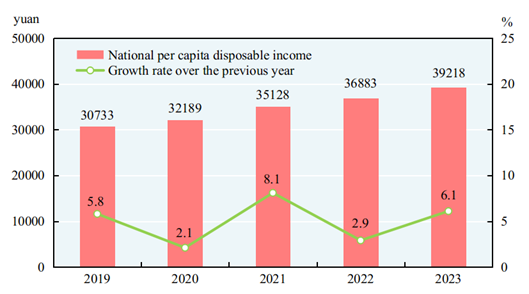
Figure 19: National Per Capita Consumption Expenditure and Composition in 2023
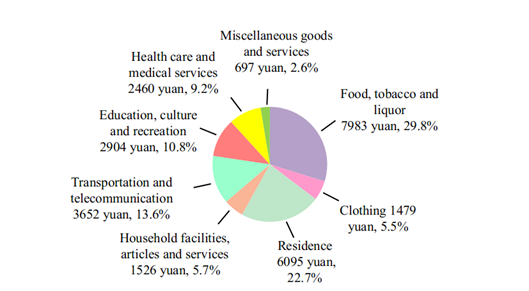
By the end of 2023, a total of 521.21 million people participated in the basic endowment insurance program for urban workers, an increase of 17.66 million over that by the end of 2022. A total of 545.22 million people participated in basic endowment insurance program for urban and rural residents, a decrease of 4.30 million. A total of 1,333.87 million people participated in basic medical insurance program[60]. Of this total, 370.94 million people participated in the program for workers, and 962.93 million people participated in the program for urban and rural residents. A total of 243.73 million people participated in unemployment insurance program, an increase of 5.66 million. The number of people receiving unemployment insurance payment stood at 3.52 million. A total of 301.70 million people participated in work-related injury insurance, an increase of 10.54 million. A total of 249.07 million people participated in maternity insurance programs. By the end of 2023, minimum living allowances were granted to 6.64 million urban residents and 33.99 million rural residents, 4.35 million rural residents living in extreme poverty[61] received relief and assistance and 7.42 million person-times of temporary assistance[62] were provided. National pensions and subsidies were regularly provided to 8.34 million ex-servicemen and other entitled people in 2023.
By the end of 2023, there were altogether 44 thousand social welfare institutions providing accommodation, of which 41 thousand were elderly care institutions and 971 were institutions for child welfare, assistance and protection. The social welfare institutions provided 8.463 million beds[63], of which 8.201 million were for the elderly and 98 thousand were for children.
X. Science & Technology and Education
Expenditures on research and experimental development activities (R&D) were 3,327.8 billion yuan in 2023, up by 8.1 percent over that of 2022, accounting for 2.64 percent of GDP. Of this total, 221.2 billion yuan was used for basic research programs, up by 9.3 percent over that of 2022, accounting for 6.65 percent of expenditures on R&D. A total of 52.5 thousand projects were financed by the National Natural Science Foundation. By the end of 2023, there were altogether 207 national engineering research centers included into the new sequence management and 1,798 state-level enterprise technology centers. The National Fund for Technology Transfer and Commercialization established 36 sub-funds, with a total funding of 62.4 billion yuan. There were 1,606 state-level technology business incubators[64], and 2,376 national mass makerspaces[65]. A total of 921 thousand invention patents were authorized, up by 15.3 percent over that of the previous year. The number of PCT patent applications accepted[66] was 74 thousand. By the end of 2023, the number of valid invention patents was 4.991 million, up by 18.5 percent over that by the end of 2022. The number of high-value invention patents per 10,000 people[67] was 11.8. Trademark registration totaled 4.383 million, down by 29.0 percent over that of the previous year. A total of 0.95 million technology contracts were signed with 6,147.6 billion yuan worth of contracted technology transactions, up by 28.6 percent over that of the previous year. The proportion of citizens with scientific literacy[68] in China reached 14.14 percent.
Figure 20: Expenditure on Research and Experimental Development Activities (R&D) and the Growth Rates 2019-2023
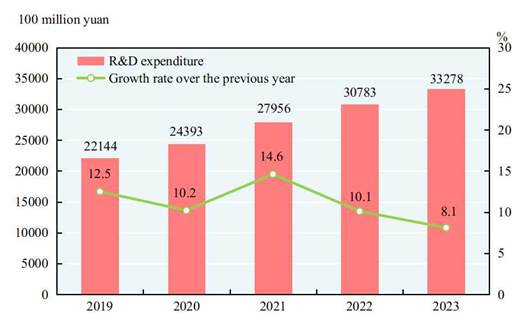
Table 17: Number of Patents Authorized and Valid Patents in 2023
|
Item |
Patents (10,000) |
Increase over 2022 (%) |
|
|
|
|
|
Number of patents authorized |
92.1 |
15.3 |
|
Of which: domestic |
81.3 |
18.0 |
|
Number of utility model patents authorized |
209.0 |
-25.5 |
|
Number of appearance design patents authorized |
63.8 |
-11.5 |
|
Number of valid invention patents at the end of the year |
499.1 |
18.5 |
|
Of which: domestic |
401.5 |
22.4 |
|
Number of valid utility model patents at the end of the year |
1212.9 |
11.9 |
|
Number of valid appearance design patents at the end of the year |
323.4 |
14.2 |
|
|
|
|
The year 2023 saw a total of 66 successful space launches. The successive launches of the Tianzhou 6, Shenzhou 16 and Shenzhou 17 led China’s space station to usher in a new phase of application and development. The world’s first liquid oxygen-methane carrier rocket, ZQ-2 Y2, blasted off successfully. The Jiuzhang 3.0 quantum computer prototype was successfully developed. The experimental advanced superconducting tokamak (EAST) achieved a steady-state high confinement plasma operation for 403 seconds. The world’s first fourth-generation high temperature gas-cooled reactor nuclear power plant has officially gone into commercial operation. The world’s first 16-megawatt ultra-large-capacity offshore wind turbine was successfully connected to the grid and began generating electricity. China’s C919 jetliner officially went into commercial operation. China’s first domestically-built large cruise ship completed its first sea trial. The deep-sea manned submersible Fendouzhe completed its deep-diving mission.
By the end of 2023, there were altogether 877 national quality inspection centers. There were 1,242 agencies for product quality, management system and service certification which certified accumulatively 1.02 million enterprises. A total of 2,902 national standards were developed or revised in the year, including 1,708 new standards. The qualification rate of manufactured products[69] reached 93.65 percent.
In 2023, graduate institutes enrolled 3.883 million students with 1.302 million entrants and 1.015 million graduates. Total enrollment in undergraduate programs in regular and vocational higher education institutes[70] was 37.750 million with 10.422 million entrants and 10.470 million graduates. The enrollment in secondary vocational education[71] was 17.379 million, including 6.165 million entrants, and 5.371 million graduates. Regular senior secondary schools had 28.036 million enrolled students, including 9.678 million entrants, and 8.604 million graduates. Students enrolled in junior secondary schools totaled 52.437 million, including 17.546 million entrants, and 16.236 million graduates. The country had a primary education enrollment of 108.360 million, including 18.779 million entrants, and 17.635 million graduates. There were 0.912 million students enrolled in special education schools, with 0.155 million entrants and 0.173 million graduates. Kindergartens accommodated 40.930 million children. The number of students who graduated from compulsory education reached 95.7 percent of the total enrollment, and the gross enrollment ratio for senior secondary education reached 91.8 percent.
Figure 21: Entrants in Education 2019-2023
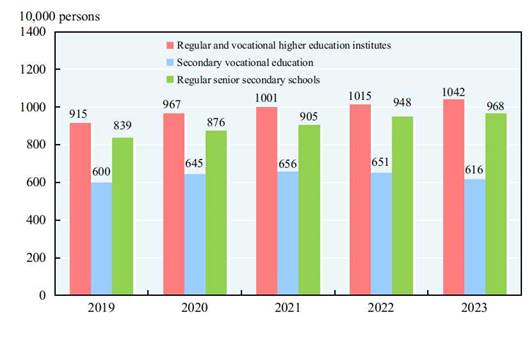
XI. Culture and Tourism, Public Health and Sports
By the end of 2023, there were 1,893 art-performing groups affiliated to government culture and tourism departments throughout China. A total of 3,309 public libraries received[72] 1,126.68 million person-times of visits. There were 3,508 cultural centers. Subscribers to cable television programs numbered 202 million, among which 193 million subscribed to digital cable television programs. By the end of 2023, radio broadcasting and television broadcasting coverage rates were 99.7 percent and 99.8 percent respectively. A total of 4,632 episodes of 156 TV series and 93,811 minutes of TV cartoons were produced in 2023. The country developed 792 feature movies and 179 popular science movies, documentaries, animation and special movies[73]. A total of 25.8 billion copies of newspapers and 1.8 billion copies of magazines were issued, and 11.9 billion copies of books were published. The average number of books possessed per person[74] was 8.40 copies. By the end of the year, there were 4,154 archives in China and 238.27 million files were made accessible to the public. The business revenue of enterprises above the designated size engaged in culture and related industries reached 12,951.5 billion yuan, up by 8.2 percent over that of the previous year on a comparable basis.
In 2023, a total of 4.89 billion domestic trips were made, up by 93.3 percent over that of the previous year. Of this total, the number of trips made by urban residents was 3.76 billion, an increase of 94.9 percent; and the number of trips made by rural residents was 1.13 billion, an increase of 88.5 percent. The expenditure of domestic tourists was 4,913.3 billion yuan, an increase of 140.3 percent. Of this total, tourists from urban areas spent 4,178.1 billion yuan, an increase of 147.5 percent; and tourists from rural areas spent 735.3 billion yuan, an increase of 106.4 percent. The number of inbound visits to China totaled 82.03 million. Of this total, 13.78 million were made by foreigners and 68.24 million by Chinese compatriots from Hong Kong, Macao and Taiwan. The expenditures of inbound visitors to China totaled 53.0 billion US dollars. The number of China’s outbound visits totaled 100.96 million. Of this total, 96.84 million were private visits and 77.04 million were to Hong Kong, Macao and Taiwan.
Figure 22: Person-times of Domestic Tourists and the Growth Rates 2019-2023
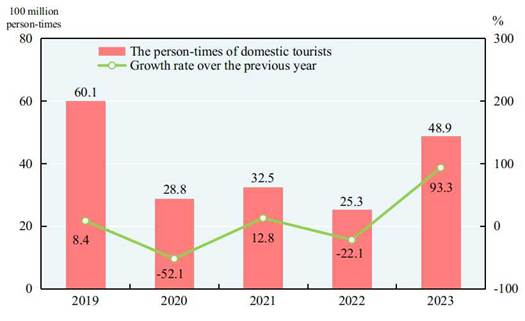
By the end of 2023, there were 1.071 million medical and health institutions in China, including 39 thousand hospitals. Of all the hospitals, 12 thousand were public, and 27 thousand were private. Of the 1.016 million medical and health institutions at grass-root level, 34 thousand were town and township health centers, 37 thousand community health service centers, 362 thousand clinics and 583 thousand village clinics. Of the 12 thousand professional public health institutions, 3,426 were disease control and prevention centers and 2,791 were health monitoring institutions. By the end of 2023, there were 12.47 million medical technical personnel in China, including 4.78 million licensed doctors and licensed assistant doctors and 5.63 million registered nurses. The medical and health institutions in China had 10.20 million beds, of which hospitals had 8.00 million and township health centers had 1.51 million. The total number of medical visits[75] and hospital discharges[76] in 2023 reached 9.56 billion and 0.3 billion respectively.
Figure 23: Year-end Number of Medical Technical Personnel 2019-2023
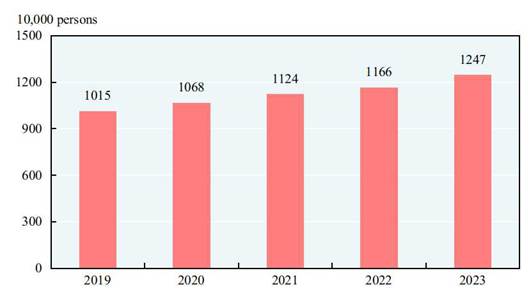
There were altogether 4.593 million sports venues[77]. The sports venue area[78] totaled 4.07 billion square meters and the per capita sports venue area was 2.89 square meters. In 2023, Chinese athletes won 165 world championships in 32 sport competitions and broke 20 world records. At the 19th Asian Games in Hangzhou, Chinese athletes won 201 gold medals and a total of 383 medals, topping the gold medal tally for 11 times in a row at the Asian Games. Chinese physically-challenged athletes won 231 world championships in 45 international sport competitions. At the 4th Asian Paralympic Games in Hangzhou, Chinese athletes won 214 gold medals and a total of 521 medals, topping the gold medal tally and overall medal count for four times in a row at the Asian Paralympic Games.
XII. Resources, Environment and Emergency Management
In 2023, the total supply of state-owned land for construction use[79] was 749 thousand hectares, a decrease of 2.1 percent over that of the previous year. Of this total, the land supply for industry, mining and warehousing was 175 thousand hectares, down by 11.9 percent; that for real estate[80] was 84 thousand hectares, down by 23.3 percent; and that for infrastructure facilities was 490 thousand hectares, up by 7.2 percent.
The total stock of water resources in 2023 was 2,478.0 billion cubic meters. With a decrease of 1.5 percent over 2022, the total water consumption was 590.7 billion cubic meters, of which water consumption for domestic use was up by 0.5 percent, for industrial use up by 0.2 percent, for agricultural use down by 2.9 percent, and the artificial recharge for environmental and ecological use grew by 3.9 percent. Water consumption per 10,000 yuan of GDP[81] was 50 cubic meters, a decline of 6.4 percent. Water consumption per 10,000 yuan of industrial value added was 26 cubic meters, down by 3.9 percent. The per capita water consumption was 419 cubic meters, down by 1.4 percent.
In 2023, the total area of afforestation reached 4.00 million hectares, of which 1.33 million hectares were afforested by manpower, accounting for 33.4 percent of the total. The land area improved by grass plantation[82] was 4.38 million hectares. By the end of 2023, there were 5 national parks. A total of 63 thousand square kilometers of land have been saved from soil erosion.
Preliminary estimation indicated that the total energy consumption in 2023 amounted to 5.72 billion tons of standard coal equivalent, up by 5.7 percent over that of 2022. The consumption of coal increased by 5.6 percent; crude oil, up by 9.1 percent; natural gas, up by 7.2 percent; and electric power, up by 6.7 percent. The consumption of coal accounted for 55.3 percent of the total energy consumption, 0.7 percentage points lower than that of 2022, while clean energy consumption, such as natural gas, hydropower, nuclear power, wind power and solar power accounted for 26.4 percent, 0.4 percentage points higher. The comprehensive energy consumption per unit calcium carbide by major energy-intensive industrial enterprises went down by 0.8 percent, per unit synthetic ammonia up by 0.9 percent, per ton steel up by 1.6 percent and per unit electrolytic aluminium down by 0.1 percent. The standard coal consumption per kilowatt-hour of thermal power generation decreased by 0.2 percent. Accroding to preliminary estimates, the energy consumption per 10,000 yuan worth of GDP[83] decreased by 0.5 percent over that of the previous year after deducting the consumption of raw materials and non-fossil energy. The trade volume of carbon emission quotas[84] at the China Carbon Emissions Trade Exchange reached 212 million tons with a turnover totaling 14.44 billion yuan.
Figure 24: Proportion of Clean Energy Consumption in the Total Energy Consumption 2019-2023
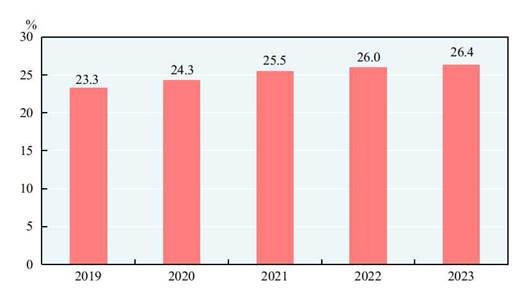
The area of offshore oceanic water[85] that met the national quality standard Grade I and II accounted for 85.0 percent; that met Grade III standard 4.5 percent; and water of Grade IV or inferior quality 10.5 percent.
Of the monitored 339 cities at prefecture level and above, the annual average concentration of particulate matter (PM2.5) was 30 micrograms per cubic meter, up by 3.4 percent over the previous year.
Of the 326 cities subject to urban regional daytime acoustic environment monitoring, 5.8 percent enjoyed excellent environment, 69.3 percent had good environment, 23.9 percent had average environment, 0.9 percent had relatively poor environment and no city had poor environment in 2023.
The average temperature in 2023 was 10.71℃, up by 0.21℃ compared with that of the previous year. Typhoons hit China 6 times in 2023.
In 2023, natural disasters hit 10.54 million hectares of crops, of which 0.98 million hectares of crops were demolished. Flood, waterlogging and geological disasters caused a direct economic loss of 245.1 billion yuan. Droughts caused a direct economic loss of 20.6 billion yuan. Disasters caused by low temperature, frost and snow made a total direct economic loss of 4.9 billion yuan. Oceanic disasters caused a direct economic loss of 2.5 billion yuan. The country recorded 11 earthquakes with magnitude 5.0 and above, causing a direct economic loss about 15.3 billion yuan. The year 2023 witnessed 328 forest fires, with 4 thousand hectares of forests damaged.
The death toll due to work accidents amounted to 21,242 people in 2023,down[86] by 4.7 percent over that of the previous year. Work accidents in industrial, mining and commercial companies caused 1.244 deaths out of every 100 thousand employees, up by 4.2 percent over that of 2022. The death toll for one million tons of coal produced in coal mines was 0.094 people, up by 23.7 percent. The road traffic death toll per 10 thousand vehicles was 1.38 people, down by 5.5 percent.
Notes:
[1] All figures in this Communiqué are preliminary statistics. Statistics in this Communiqué do not include Hong Kong SAR, Macao SAR and Taiwan Province. Due to the rounding-off reasons, the subentries may not add up to the aggregate totals.
[2] Gross domestic product (GDP), value added of the three and related industries, regional GDP, per capita GDP and gross national income (GNI) as quoted in this Communiqué are calculated at current prices whereas their growth rates are at constant prices.
[3] Gross national income, also known as gross national product, refers to the total primary distribution of the income created by all the resident units of a country (or a region) during a certain period of time. It equals to gross domestic product plus the net primary distribution of income from abroad.
[4] The overall labor productivity refers to the ratio between the GDP (at 2020 constant prices) and the total number of persons employed.
[5] The national population refers to the population of the 31 provinces, autonomous regions and municipalities directly under the central government and servicemen of the Chinese mainland, excluding residents of Hong Kong, Macao and Taiwan and foreigners living in the 31 provinces, autonomous regions and municipalities directly under the central government.
[6] By the end of 2023, the population aged 0 to 14 (under the age of 15) was 230.63 million and that aged 15 to 59 (under the age of 60) was 882.07 million.
[7] The number of newly increased employed people in urban areas equals the number of cumulative new employment minus the number of natural attrition in urban areas during the reporting period.
[8] The number of migrant workers includes those who are employed outside their villages and towns for more than six months in the year and those who are engaged in non-agricultural work in their villages and towns for more than six months in the year.
[9] The producer prices for farm products refer to the prices of farm products sold firsthand by producers.
[10] The prices for residence include prices for rent, maintenance and management, water, electricity and fuel, and services for owner-occupied housing etc.
[11] The growth rates and rate changes of relevant indicators of the industries above the designated size in 2023 were calculated on a comparable basis due to adjustments of survey coverage in the statistical survey programs, statistical law enforcement and removal of duplicated data.
[12] Manufacture of equipment includes manufacture of metal products, general purpose equipment, special purpose equipment, automobiles, railway, ship, aerospace and other transport equipment, electrical machinery and apparatus, computers, communication and other electric equipment and measuring instrument and machinery.
[13] High technology manufacturing industry includes manufacture of medicine, manufacture of aerospace vehicle and equipment, manufacture of electronic and communication equipment, manufacture of computers and office equipment, manufacture of medical equipment, manufacture of measuring instrument and equipment and manufacture of optical and photographic equipment.
[14] Service enterprises above the designated size refer to legal entities of transport, storage and post, information transmission, software and information technology services, water conservancy, environment and public facilities management, and health with annual business revenue of 20 million yuan and above; legal entities of real estate (excluding real estate development and operation), leasing and business services, scientific research and technology services and education with annual business revenue of 10 million yuan and above; and legal entities of services to households, repair and other services and culture, sports and entertainment, and social services with annual business revenue of 5 million and above. The growth rates of financial indicators of service enterprises above the designated size in 2023 were calculated on a comparable basis.
[15] Strategic emerging service industries refer to the related service sectors of information technology of new generation, manufacture of high-end equipment, new materials, biotech, new energy vehicles, new energy, energy-saving and environmental protection and digital creative industries, and service industries related to new technology, innovation and entrepreneurship.
[16] Investment in high technology industries refers to investment in six high technology manufacturing industries, including the manufacture of medicine and manufacture of aerospace vehicle and equipment, and nine high technology service industries, including information service and e-commerce service.
[17] The investment in technology transformation of manufacturing refers to the investment by manufacturing enterprises in transformation of existing facilities, techniques and production services by adopting new technologies, techniques, devices and materials.
[18] E-commerce transactions refer to the transactions of goods and services realized through e-commerce trading platforms (including self-built and third-party platforms), including transactions with entities and individuals. The growth rate of 2023 was calculated on a comparable basis.
[19] Online retail sales refer to the retail sales of goods and services realized through internet trading platforms (online platforms mainly in trading physical commodities, including self-built websites and third-party platforms). The growth rate of 2023 was calculated on a comparable basis.
[20] The eastern areas include 10 provinces and municipalities: Beijing, Tianjin, Hebei, Shanghai, Jiangsu, Zhejiang, Fujian, Shandong, Guangdong and Hainan; the central areas cover 6 provinces: Shanxi, Anhui, Jiangxi, Henan, Hubei and Hunan; the western areas include 12 provinces, autonomous regions and municipalities: Inner Mongolia, Guangxi, Chongqing, Sichuan, Guizhou, Yunnan, Tibet, Shaanxi, Gansu, Qinghai, Ningxia and Xinjiang; the northeastern areas include 3 provinces: Liaoning, Jilin and Heilongjiang.
[21] The carbon dioxide emissions per 10,000 yuan worth of GDP was calculated at 2020 constant prices.
[22] See Note 11.
[23] The data included the steel reprocessed among enterprises.
[24] Capacity utilization rate refers to the ratio of the actual production to the production capacity (in terms of value). Actual production refers to the total industrial output value during the enterprise’s reporting period. Production capacity refers to the production which can be realized and sustained for a long term under the condition of the supply of labor force, materials, fuel and transportation guaranteed and the production equipment in proper operation during the reporting period.
[25] Thermal power refers to electricity generated by coal, oil, gas, residual heat, pressure and gas, waste incineration and biomass.
[26] A few installed power generation capacity (e.g. geothermal) is not listed.
[27] The growth rate of the profits made by construction enterprises was calculated on a comparable basis. Factors causing incomparability between the data of reporting period and the data released of the same period in the previous year made it impossible to calculate the growth rate directly. The main reasons were as below: ① Data of principal businesses that were not within the coverage of construction industry were removed in the data quality review. ② Problematic data were spotted and revised according to relevant rules as a result of statistical law enforcement.
[28] The total freight traffic and flows include the traffic and flows by railways, highways, waterways, civil aviation and pipelines and the growth rates in 2023 were calculated on a comparable basis.
[29] The volume of postal and delivery services refers to the total volume of universal postal services and express delivery services provided by enterprises.
[30] The turnover of telecommunication services was calculated based on the prices of the previous year.
[31] The number of mobile phone base stations refers to the total number of wireless transceivers serving communities that handle the wireless communication between the base stations and mobile stations, relay between the mobile switchboards and mobile stations, and monitor the quality of wireless transmission at the end of the reporting period.
[32] Fixed broadband internet users refer to those who subscribed to the telecommunication enterprises and accessed the Internet through xDSL, FTTx+LAN, FTTH/0 and other broadband access ways as well as general dedicated lines at the end of the reporting period.
[33] Users of broadband with the speed of 100M and above refer to those who enjoy a downstream rate of 100Mbit/s or above at the end of the reporting period.
[34] Users of cellular internet of things terminals refer to those who access the mobile internet and subscribe to the internet of things services at the end of the reporting period. Internet of things terminals refers to the internet of things devices that connect the sensing network layer and the transmission network layer to implement remote data collection and data transmission to the network layer.
[35] Software and information technology services industry includes software development, integrated circuit design, information system integration and internet of things technology services, operation maintenance services, information processing and storage support services, IT consulting services, digital content services and other IT services industry. The growth rate of software revenue of software and information technology services industry in 2023 was calculated on a comparable basis.
[36] The retail sales of services refer to the total value of services directly provided by enterprises (establishments, self-employed units) to individuals and other units for non-production and non-operating purposes in the form of transactions. It aims to reflect the value of services with the nature of consumption sold by service providers in monetary terms, including the retail sales of services in transportation, accommodation, catering, education, health, sports, entertainment, and other fields.
[37] The growth rates of relevant indicators of investment in fixed assets were calculated on a comparable basis. Factors causing incomparability between the data of reporting period and the data released of the same period in the previous year made it impossible to calculate the growth rates directly. The main reasons were as below: ① The upfront land costs which should not be included as investment completed in the reporting period, as well as duplicated data across regions and industries were removed as data quality review and assessment methods were improved. ② Current assets and consumptive biological assets that were not within the statistical coverage of investment in fixed assets were removed in the review over the ongoing investment projects. ③ Problematic data were spotted and revised according to relevant rules as a result of statistical law enforcement.
[38] See Note 20.
[39] Investment in infrastructure includes investment in railway transportation, highway transportation, waterway transportation, civil aviation transportation, pipeline transportation, multi-modal transportation and forwarding agency, loading, unloading and delivery, postal service, telecommunication, radio, TV and satellite transmission, internet and related services, management of water conservancy, ecological conservation and environmental governance, and management of public facilities.
[40] Investment in social sector includes investment in education, health and social services, culture, sports and recreation.
[41] Private investment in fixed assets refers to investment in the construction or purchase of fixed assets by domestic collective, private and individual-owned enterprises and institutions or their holding enterprises (including absolute holding and relative holding enterprises).
[42] The investment in real estate includes the investment in real estate development, construction of buildings for own use, property management, intermediary services and other real estate investment.
[43] The growth rates of indicators such as the investment in real estate development and the newly built commercial buildings sold were calculated on a comparable basis. Factors causing incomparability between the data of reporting period and the data released of the same period in the previous year made it impossible to calculate the growth rates directly. The main reasons were as below: ① Simple primary land development that didn’t belong to the real estate development were removed in the review over the ongoing real estate development projects. ② Data that didn’t belong to the sale of commercial buildings, such as transactions canceled and buildings mortgaged, were removed in the review over sales data of commercial buildings. ③ Problematic data were spotted and revised according to relevant rules as a result of statistical law enforcement.
[44] The floor space of newly built commercial buildings sold refers to the total contract floor space of newly built commercial buildings sold by real estate development enterprises within the reporting period.
[45] The floor space of second-hand housing online transactions refers to the total contract floor space of second-hand housing online transactions in urban areas within the reporting period.
[46] The Belt and Road refers to the Silk Road Economic Belt and the 21st Century Maritime Silk Road.
[47] Other Regional Comprehensive Economic Partnership (RCEP) member countries include Indonesia, Malaysia, Philippines, Thailand, Singapore, Brunei, Cambodia, Laos, Myanmar, Vietnam, Japan, Republic of Korea, Australia and New Zealand.
[48] The AFRE (flow) refers to the total volume of financing provided by the financial system to the real economy within a certain period of time.
[49] The AFRE (stock) refers to the outstanding financing provided by the financial system to the real economy at the end of a period of time (a month, a quarter or a year).
[50] Inclusive loans to micro and small businesses include loans to micro and small businesses with single-client credit line under 10 million yuan, operating loans to self-employed businesses and owners of micro and small businesses.
[51] Funds raised through Shanghai and Shenzhen Stock Exchanges are calculated by the money raised on the listing date, and the funds raised include the actual exchanged convertible bonds, which were 93.4 billion yuan in 2022 and 83.2 billion yuan in 2023.
[52] Funds raised through Beijing Stock Exchanges are calculated by the money raised on the listing date.
[53] National Equities Exchange and Quotations is a national securities exchange established upon approval by the State Council in 2012. Preferred stocks were excluded from funds raised by listed companies in National Equities Exchange and Quotations. Funds raised by shares are calculated by the disclosure date of the issuance report.
[54] Corporate credit bonds include debt financing instruments issued by non-financial businesses, enterprise bonds, corporate bonds and convertible bonds.
[55] The premium of primary insurance received by the insurance companies refers to the premium income from primary insurance contracts confirmed by the insurance companies.
[56] The median of per capita disposable income refers to the per capita income of household lied in the middle of all surveyed households which are ranked from low to high (or high to low) based on per capita disposable income level.
[57] The income quintile refers to the five equal partitions of all surveyed households, who are ranked from low to high based on per capita income level. The top 20 percent with the highest income are classified as high-income group, and the other four levels are upper-middle-income group, middle-income group, lower-middle-income group and low-income group.
[58] Counties lifted out of poverty include 832 key counties under the national poverty alleviation and development program and counties in contiguous poor areas as well as 7 cities and counties in Aksu prefecture, Xinjiang.
[59] The consumption expenditure on services refers to the spending by households on services for daily lives including catering, clothing and footwear processing, housing, family, transportation and telecommunication, education, culture and recreation, medical services and others.
[60] Participants in basic medical insurance program for the year 2023 had the duplicated participation removed.
[61] Rural residents living in extreme poverty refer to the aged, the disabled and the minor under 16 years of age in rural areas who have no ability to work, no sources of income and no statutory obligors to provide for them, bring them up or support them, or whose statutory obligors have no ability to fulfill their obligations.
[62] Temporary assistance refers to emergent and transitional assistance provided by the government to families or individuals who experience hardships because of emergencies, unexpected harm, major diseases or other unusual factors and are not covered by other forms of social assistance programs or still suffer hardships after receiving other social assistance programs.
[63] The beds provided by social welfare institutions include beds provided by adoption agencies, aid agencies and community agencies.
[64] The state-level technology business incubators are technology-based business startup service providers consistent with the Administrative Measures for Technology Business Incubators that provide physical space, shared facilities and professional services with the mission of advancing transformation of technological achievements, cultivating technological enterprises and fostering the entrepreneurial spirit. They should be approved and accredited by the Ministry of Science and Technology.
[65] The national mass makerspaces are new service platform for entrepreneurship and innovation that are in conformity with the Guidelines on Developing Mass Makerspaces and are reviewed and registered by the Ministry of Science and Technology in accordance with the Provisional Registration Regulations on National Mass Makerspaces.
[66] The number of PCT patent applications accepted refers to the number of PCT patent application accepted by the State Intellectual Property Office which acts as the receiving office of PCT patent application. PCT is the abbreviation of Patent Cooperation Treaty, which is a treaty for international cooperation in the field of patents.
[67] The number of high-value invention patents per 10,000 people refers to the number of valid invention patents owned per 10,000 national residents which are authorized by the China National Intellectual Property Administration and satisfy any of the following conditions: invention patents for strategic emerging industries; invention patents having corresponding foreign patents; invention patents maintained more than 10 years; invention patents with a relatively high pledge financing amount; and invention patents that won the National Science and Technology Award and the China Patent Award.
[68] Citizens with scientific literacy refer to citizens carrying out scientific spirit, spreading scientific philosophy, mastering basic scientific methods and scientific knowledge, and able to apply them to analysis and problem solving. The proportion of citizens with scientific literacy was obtained from the sample survey for citizens aged from 18 to 69.
[69] The qualification rate of manufactured products is the ratio of the samples that have passed the sampling quality test, the process of which follows certain methods, procedure and standard, to the total amount of the sampled products. The survey samples cover 29 sectors of the manufacturing industry.
[70] Regular and vocational higher education institutes include regular universities, vocational undergraduate education and higher vocational colleges.
[71] Secondary vocational education includes regular specialized secondary schools, adult specialized secondary schools, vocational high schools and skilled workers schools.
[72] The people received by the public libraries refer to the number of people who visit libraries and use library services in the year, including borrowing and reading books, consultation and attending readers’ programs.
[73] Special movies refer to those using different display modes in terms of projection techniques, equipment and program as compared with the ordinary cinemas, such as IMAX movies, 3D movies, 4D movies, multidimensional movies and full dome movies.
[74] The average number of books possessed per person refers to the average number of books published in the year that can be possessed per person in China.
[75] The total number of medical visits refers to the number of people receiving medical services, including outpatient services, emergency treatment, home visits, appointment-based diagnosis and treatment, health check-up of a specific item, and health consultation and guidance (excluding health lectures and nucleic acid tests).
[76] The number of hospital discharges refers to the number of inpatients discharged from hospitals in the reporting period, including those who are discharged from hospitals or transferred to other medical institutions following doctors’ advice, discharged from hospitals without doctors’ permission, dead or other situations. The number of people who are recovered from family sickbeds is excluded.
[77] The sports venues belonging to armed forces and railway system are excluded in the census on sports venues.
[78] The sports venue area refers to area used for physical training, sports competitions and physical fitness.
[79] Total supply of state-owned land for construction use refers to the total amount of state-owned land for construction use with the land-use right transferred, allocated or leased to units or individuals through signed transaction contracts and allocation decisions by the municipal or county governments according to annual land supply plan and in line with relevant laws in the reporting period.
[80] Land used for real estate refers to the sum of land used for commercial service and for residence.
[81] The water consumption per 10,000 yuan of GDP and water consumption per 10,000 yuan of industrial value added are calculated at prices of 2020.
[82] The land area improved by grass plantation refers to the area of grasslands that are ecologically restored through manual grass plantation, aerial grass seeding, the quality improvement of grasslands and fencing enclosure.
[83] The energy consumption per 10,000 yuan worth of GDP is calculated at prices of 2020.
[84] The trade volume of carbon emission quotas at the China Carbon Emissions Trade Exchange refers to the emission quotas of greenhouse gases such as carbon dioxide allocated to major emission entities for the prescribed period at the China Carbon Emissions Trade Exchange.
[85] Offshore oceanic water quality is evaluated by the area method.
[86] Data of work accidents in 2022 were verified and adjusted; and the year-on-year change for 2023 were calculated based on the adjusted data of the previous year.
Data Sources:
In this Communiqué, data of newly increased employed people in urban areas, endowment insurance, unemployment insurance, work injury insurance and skilled workers schools in secondary vocational education are from the Ministry of Human Resources and Social Security; data of foreign exchange reserves and exchange rates are from the State Administration of Foreign Exchange; data of business entities, quality inspection, the formulation and revision of national standards and qualification rate of manufactured products are from the State Administration for Market Regulation; data of environment monitoring and carbon emission trading are from the Ministry of Ecology and Environment; data of output of aquatic products, area of high-standard farmland newly developed and upgraded and area of farmland newly equipped with water-saving irrigation systems are from the Ministry of Agriculture and Rural Affairs; data of production of timber, area of afforestation, area of grass planting and improvement and national parks are from the National Forestry and Grassland Administration; data of water resources, water consumption and land newly saved from soil erosion are from the Ministry of Water Resources; data of installed power generation capacity, newly increased alternating current transformer equipment with a capacity of over 220 kilovolts and electricity consumption are from the China Electricity Council; data of volume of freight handled by ports, container shipping of ports, highway transportation, waterway transportation, new and rebuilt highways and new throughput capacity of berths for over 10,000-tonnage ships are from the Ministry of Transport; data of railway transportation, new railways put into operation, extended or new double-track railways put into operation and electrified railways put into operation are from China Railway; data of civil aviation and new civil transportation airports are from the Civil Aviation Administration of China; data of pipeline transportation are from China National Petroleum Corporation, China Petrochemical Corporation, China National Offshore Oil Corporation and China Oil & Gas Piping Network Corporation; data of motor vehicles for civilian use and traffic accidents are from the Ministry of Public Security; data of postal service are from the State Post Bureau; data of telecommunication, software revenue, and new lines of optical-fiber cables are from the Ministry of Industry and Information Technology; data of internet users and internet coverage are from the China Internet Network Information Center; data of floor space of second-hand housing online transactions, housing units rebuilt in rundown urban areas, government-subsidized rental housing and renovation of old urban residential communities are from the Ministry of Housing and Urban-Rural Development; Data of imports and exports of goods are from the General Administration of Customs; data of imports and exports of services, foreign direct investment, outbound direct investment, overseas contracted projects and overseas labor contracts are from the Ministry of Commerce; data of finance are from the Ministry of Finance; data of newly added tax and fee cuts, deferrals and tax refunds are from the State Taxation Administration; data of monetary finance and corporate credit bonds are from the People’s Bank of China; data of funds raised through domestic exchange markets are from China Securities Regulatory Commission; data of the insurance sector are from the National Financial Regulatory Administration; data of medical insurance and maternity insurance are from the National Healthcare and Security Administration; data of urban and rural minimum living allowances, relief and assistance granted to rural residents living in extreme poverty, temporary assistance and social welfare are from the Ministry of Civil Affairs; data of entitled people are from the Ministry of Veterans Affairs; data of natural science foundation projects are from the National Natural Science Foundation; data of National Fund for Technology Transfer and Commercialization, state-level technology business incubators, national mass makerspaces and technology contracts are from the Ministry of Science and Technology; data of national engineering research centers and state-level enterprises technical centers are from the National Development and Reform Commission; data of patents and trademarks are from the National Intellectual Property Administration; data of the proportion of citizens with scientific literacy are from the China Association for Science and Technology; data of satellite launches are from the State Administration of Science, Technology and Industry for National Defense; data of education are from the Ministry of Education; data of art-performing groups, public libraries, cultural centers and tourism are from the Ministry of Culture and Tourism; data of television and radio programs are from the National Radio and Television Administration; data of movies are from the China Film Administration; data of newspapers, magazines and books are from the National Press and Publication Administration; data of files are from the State Archives Administration; data of China’s outbound visits are from the National Immigration Administration; data of medical care and health are from the National Health Commission; data of health supervision are from the National Disease Control and Prevention Administration; data of sports are from the General Administration of Sport; data of physically-challenged athletes are from the China Disabled Persons’ Federation; data of supply of state-owned land for construction use and direct economic loss caused by oceanic disasters are from the Ministry of Natural Resources; data of average temperature and typhoons are from the China Meteorological Administration; data of areas of crops hit by natural disasters, direct economic loss caused by flood, waterlogging and geological disasters, direct economic loss caused by droughts, direct economic loss caused by low temperature, frost and snow, the number of earthquakes, direct economic loss caused by earthquakes, forest fires, areas of forests damaged and workplace accidents are from the Ministry of Emergency Management; all the other data are from the National Bureau of Statistics.
In case of any differences between English translation and the original Chinese text, the Chinese edition shall prevail.
